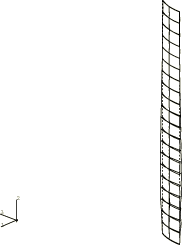General description
Collapse studies of a structure's postbuckling load-displacement (Riks) behavior are often conducted to verify that the critical buckling load and mode predicted by an eigenvalue buckling analysis are accurate. They are also done to investigate the effect of an initial geometric imperfection on the load-displacement response. A typical assumption is that an imperfection made up of a combination of the eigenmodes associated with the lowest eigenvalues will be the most critical. One method of introducing an imperfection of this type into the model is by adding to the original mesh coordinates. In this case is the ith eigenmode, is a scaling factor of the ith eigenmode, and M is the total number of eigenmodes extracted in the buckling analysis. Since the eigenvector is typically normalized to a maximum absolute value of one, is usually some fraction of a geometric parameter, such as the shell thickness. The postprocessing program described below can be used to introduce an imperfection of this type into a model.
The perturbation procedure is illustrated in
Buckling of a cylindrical shell under uniform axial pressure.
An eigenvalue buckling analysis, fpert001, is
run first. This analysis creates the results file,
fpert001.fil, which contains the original nodal
coordinates and the eigenvectors for the buckling modes. This results file is
then used to generate a perturbed mesh for the postbuckling load-displacement
analysis. The postprocessing program perturbs the original mesh using the
relation
where
is the vector containing the new global coordinates;
is the vector of original coordinates; M is the number of
buckling modes; and
is the imperfection factor for the ith eigenvector,
.
The new coordinates are written to the file fpert002.015,
which is read by the load-displacement analysis
fpert002.

